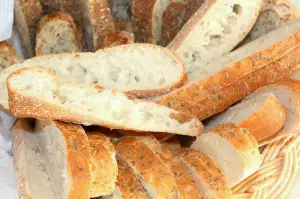Deliciously Satisfying Keto Bread Recipes to Fuel Your Low-Carb Journey

Keto bread has become a popular choice for those following a ketogenic diet. This low-carb, high-fat bread alternative allows individuals to enjoy the taste and texture of bread without compromising their dietary goals. Whether you're looking to reduce your carbohydrate intake or maintain ketosis, keto bread offers a delicious solution. In this article, we will explore the benefits of keto bread, the basic ingredients needed to make it, step-by-step instructions for baking it, variations and additions to enhance its flavor, tips for achieving the perfect loaf, and suggestions for serving and storing this delectable treat. So let's dive into the world of keto bread and discover how it can fuel your low-carb journey!
Benefits of Keto Bread for a Ketogenic Diet
Keto bread offers numerous benefits for those following a ketogenic diet. Firstly, it allows individuals to enjoy the taste and texture of bread without compromising their low-carb lifestyle. This is especially important as traditional bread is high in carbohydrates, which can disrupt ketosis.
Additionally, keto bread provides a source of dietary fiber, which is essential for maintaining digestive health and promoting feelings of fullness. It also contains healthy fats that help keep you satiated and provide sustained energy throughout the day.
Moreover, keto bread can be customized to fit specific dietary needs and preferences. Whether you prefer a savory or sweet flavor profile, there are endless variations and additions that can be incorporated into the recipe.
By incorporating keto bread into your ketogenic diet, you can continue to enjoy the satisfaction of eating bread while staying on track with your low-carb goals.
Basic Ingredients for Keto Bread
When it comes to making keto bread, the ingredients are key. Unlike traditional bread recipes that rely on wheat flour, sugar, and yeast, keto bread requires a different set of ingredients to keep it low-carb and high in healthy fats. Some basic ingredients you'll need for keto bread include almond flour or coconut flour, eggs, butter or coconut oil, baking powder, and salt. These ingredients work together to create a dough-like consistency that can be baked into a delicious loaf of bread without the guilt of traditional carbs.
Step-by-Step Instructions for Making Keto Bread
1. Preheat your oven to 350°F (175°C) and line a loaf pan with parchment paper.
2. In a large mixing bowl, combine 2 cups of almond flour, ¼ cup of coconut flour, 1 teaspoon of baking powder, and a pinch of salt.
3. In a separate bowl, whisk together 4 eggs and ½ cup of melted butter or coconut oil until well combined.
4. Gradually add the wet ingredients to the dry ingredients, stirring until a thick batter forms.
5. Pour the batter into the prepared loaf pan and smooth the top with a spatula.
6. Bake for 40-45 minutes or until golden brown and a toothpick inserted into the center comes out clean.
7. Remove from the oven and let it cool in the pan for 10 minutes before transferring to a wire rack to cool completely.
8. Once cooled, slice and enjoy your homemade keto bread!
Note: Feel free to experiment with different flavors by adding herbs, spices, or even cheese to the batter before baking.
Variations and Additions to Keto Bread Recipes
One of the best things about keto bread is its versatility. While the basic recipe is delicious on its own, you can also experiment with different variations and additions to enhance the flavor and texture.
For a savory twist, try adding herbs and spices like garlic powder, onion powder, or dried rosemary to the dough. This will give your bread a fragrant aroma and an extra burst of flavor.
If you have a sweet tooth, consider incorporating low-carb sweeteners like stevia or erythritol into your keto bread recipe. You can also add in some vanilla extract or cinnamon for a delightful hint of sweetness.
To make your keto bread more nutritious, you can mix in some chopped nuts or seeds. Almonds, walnuts, flaxseeds, or chia seeds are excellent choices that will add crunch and healthy fats to your bread.
For those who love cheese, why not try adding grated Parmesan or cheddar cheese to the dough? This will create a cheesy keto bread that pairs perfectly with soups or salads.
Another option is to experiment with different types of flour substitutes. Instead of using almond flour as the base, you can try coconut flour or flaxseed meal for a slightly different taste and texture.
Remember to adjust the quantities accordingly when adding these variations and additions to your keto bread recipe. It's all about finding what works best for your taste buds while still keeping it low-carb and ketogenic-friendly.
So go ahead and get creative in the kitchen! With these variations and additions, you can enjoy a wide range of delicious keto bread options that will keep you satisfied on your low-carb journey.
Tips for Baking the Perfect Keto Bread
1. Use a combination of almond flour and coconut flour for the best texture and flavor.
2. Make sure to sift the dry ingredients to remove any lumps and ensure even distribution.
3. Incorporate beaten egg whites into the batter to add lightness and structure.
4. Let the dough rest before baking to allow the flavors to develop and the ingredients to bind together.
5. Preheat your oven properly and use an oven thermometer to ensure accurate temperature control.
6. Line your loaf pan with parchment paper or grease it well to prevent sticking.
7. Bake at a slightly lower temperature than traditional bread recipes as keto bread tends to brown quickly.
8. Keep an eye on the bread while it bakes, as it can go from perfectly golden to burnt in a matter of minutes.
9. Allow the bread to cool completely before slicing, as this will help it hold its shape better.
10. Store leftover keto bread in an airtight container at room temperature for up to 3 days or freeze for longer shelf life.
By following these tips, you'll be able to bake deliciously satisfying keto bread that perfectly complements your low-carb journey.
Serving and Storing Keto Bread
Once your delicious keto bread is baked to perfection, it's time to enjoy it! Serve slices of warm keto bread with butter or your favorite low-carb spread. It makes a fantastic accompaniment to soups, salads, or as a base for sandwiches.
To store your keto bread, allow it to cool completely before wrapping it tightly in plastic wrap or storing it in an airtight container. It can be kept at room temperature for up to 3 days. For longer storage, refrigerate the bread for up to a week or freeze it for up to 3 months.
When you're ready to enjoy your stored keto bread, simply reheat individual slices in a toaster or oven until warmed through. The texture may change slightly after being stored, but the flavor will still be deliciously satisfying.
Remember, homemade keto bread does not contain any preservatives like store-bought bread, so it's best enjoyed within a few days of baking. So go ahead and savor every bite of your freshly baked keto bread while it's at its peak!
In conclusion, incorporating keto bread into your ketogenic diet can be a delicious and satisfying way to stay on track with your low-carb lifestyle. With its low carb and high fat content, keto bread provides a great alternative to traditional breads while still allowing you to enjoy your favorite sandwiches and toast. By using the basic ingredients and following the step-by-step instructions, you can easily make your own keto bread at home. Don't be afraid to get creative with variations and additions to suit your taste preferences. Remember to follow the tips for baking the perfect keto bread and once it's ready, enjoy it fresh or store it for later use. So go ahead and indulge in these deliciously satisfying keto bread recipes as you continue on your low-carb journey!
Published: 27. 11. 2023
Category: Recipes



